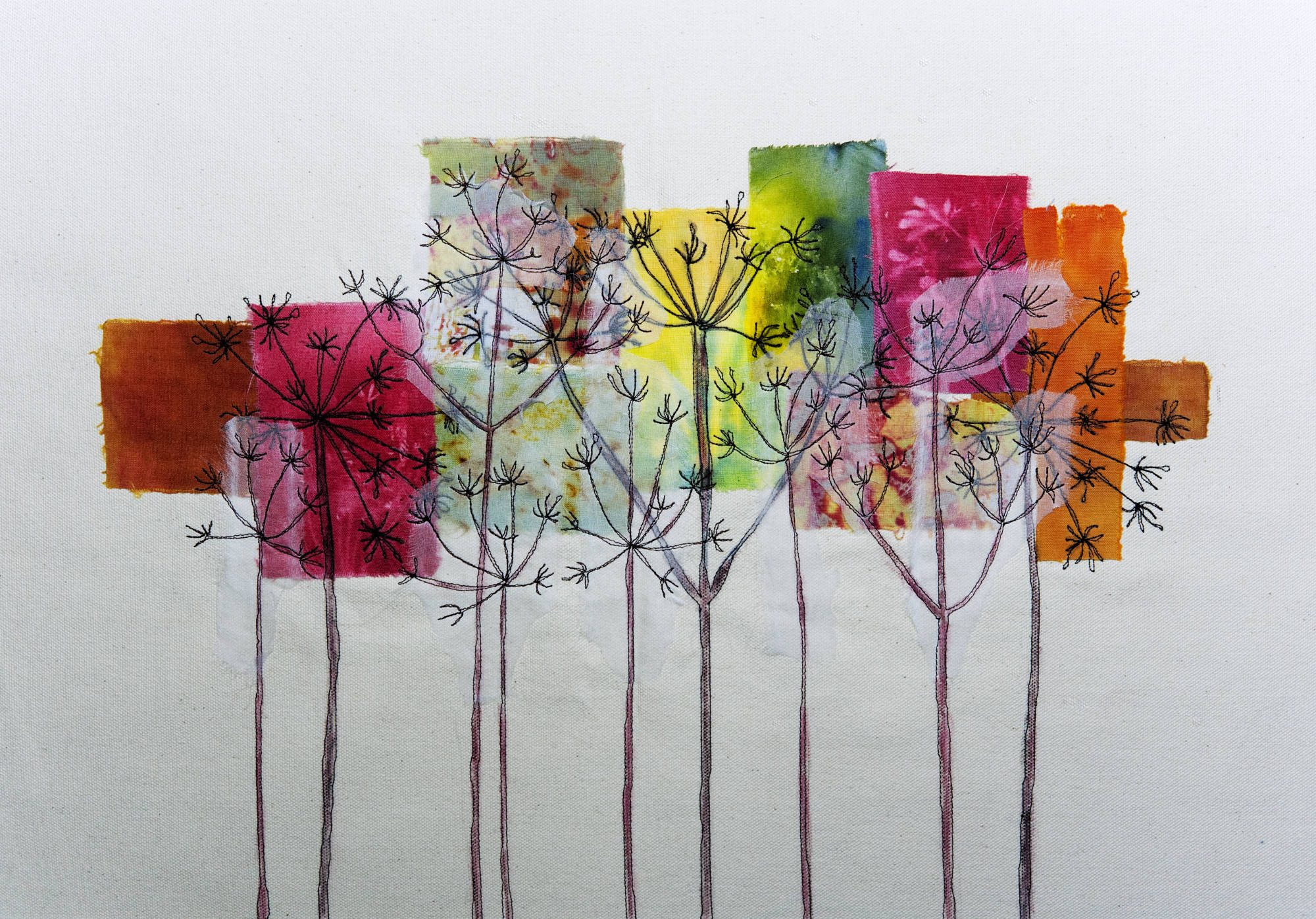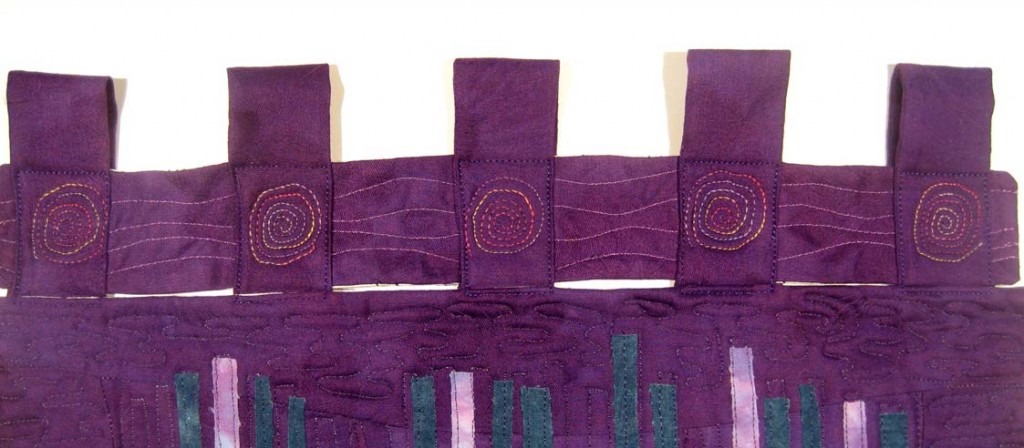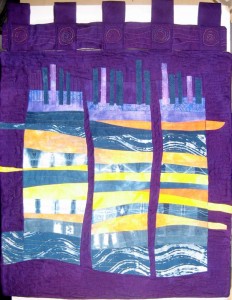PART ONE – FINISHES
Linings
As well as the traditional way of using a lining that does not show on the outside of the work, sometimes it is effective for the lining edge to show as a contrast to the outer fabric. The backing of a quilt or hanging could be used in this way.
Hangings
I like the idea of using tabs as a way of hanging a work. Having made my Monet inspired quilt as part of Module 1, I hadn’t decided how to hang it, so this seemed like a good answer. I didn’t want to detract from the quilt itself by making the hanging part too ornate, so kept the stitching very simple. each tab is secured to the back of the quilt. The tiny bit of white that appears in places is from the fabric of the quilt lining which was white with black wavy, water-like lines over it.
I will use a simple bamboo pole on which to hang the piece.
Fringes and tassels could be used as a decoration on all sorts of items, from lamps, to cushions, jewelry, belts etc. the following are samples I have made:
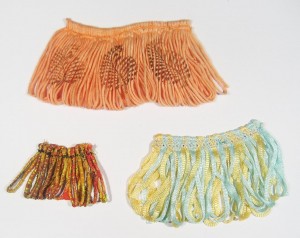 The top fringe was printed using a wooden block once made. Bottom left is made from machine wrapped cords and bottom right from two different coloured narrow ribbons.
The top fringe was printed using a wooden block once made. Bottom left is made from machine wrapped cords and bottom right from two different coloured narrow ribbons.
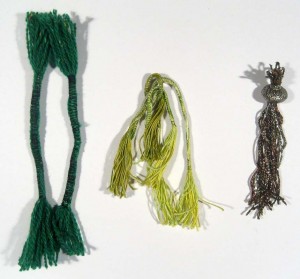 The left hand tassels are made from wool, middle from embroidery thread and the right one is metallic thread threaded through a bead. I can see the possibilities of using these in many ways, for example on the corners of cushions, or as part of a tie for a handmade book.
The left hand tassels are made from wool, middle from embroidery thread and the right one is metallic thread threaded through a bead. I can see the possibilities of using these in many ways, for example on the corners of cushions, or as part of a tie for a handmade book.
PART TWO -RESEARCHING DESIGNERS AND MAKERS
1. Amanda Hislop
[nggallery id=1]
Amanda studied woven textiles and painting and this influence is evident in her work. She says:
‘The essence of the landscape and natural forms inspire my work. I use drawing to record fleeting fragments observed and absorbed; I look at the familiar, see the extraordinary and respond to subtle changes in view in the rhythmic motion of walking. The evocative moods of seasonal change and atmospheric qualities of light and changing weather experienced when walking are a constant source of inspiration’ .She produces work inspired by sea and landscapes, layering papers, fabrics, textures, together with paint and stitch. The different layers often appear woven into each other. Some are quite representational, like the cow parsley and the shell; others are more abstract, but all I think all are very atmospheric and give a sense of having minutely observed what is around her. You get a real sense of her connection to land and sea. I love her use of subtle colours and textures. Much of this is laid down in the backgrounds, but it is the different coloured threads used in the embroidery that really bring the works to life. The stitching is freehand, simple, like drawn lines and often fairly minimalist.
I love Amanda’s work and find it very inspiring. I did a week- long workshop with her three summers ago and it was she who introduced me to the concept of mixed media and in particular of combing this with stitch. It was also after this that I decided to study machine embroidery.
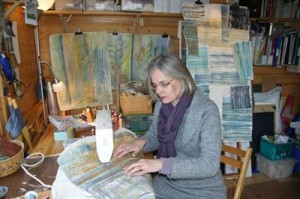 Information and photo taken from Amanda’s website. Images of her work from the website and from a booklet ‘landlines drawn lines stitch lines’.
Information and photo taken from Amanda’s website. Images of her work from the website and from a booklet ‘landlines drawn lines stitch lines’.
2. Val Holmes
[nggallery id=2]
Val trained as an embroiderer and has taught this for many years. She is constantly experimenting with different media and developing new techniques, the latest of which is the use of collagraphy for textile artists. I think that she would consider that her most important role is to allow her students to find their own creative path, rather than to be prescriptive in her teaching. I keep finding myself repeating her mantra ‘less is more’ – in other words how to produce the effect you want by suggestion rather than overkill, to really consider how stitch will integrate with a surface you have produced. I hope this influences my own work. Sometimes her stitching is quite complex and is like a painting ( eg ‘Blossom in the Drome); at other times it blends more into the overall image (eg. ‘Mist in the Marshes’). Most of her work uses free embroidery with some hand stitching.
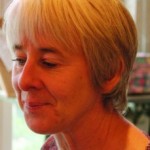 Information and photo taken from Val’s website. Images of work from the website and from two of her books: ‘Textile Art’ and ‘Collage, Stitch, Print’.
Information and photo taken from Val’s website. Images of work from the website and from two of her books: ‘Textile Art’ and ‘Collage, Stitch, Print’.
3. Tilleke Schwarz
[nggallery id=3]
Tilleke is from the Netherlands and trained mainly in painting and drawing but now uses textiles in her work. Folk art, cats and daily life are her inspiration and her style is naïve, quirky and humorous. She says her mother taught her embroidery and there is a certain ‘old fashioned’ style to much of it. Most of it is hand embroidery, with a little free machine embroidery. She calls her works maps of modern life and indeed you need to study them like a map to understand what she is trying to say, reading the words as well as the images. This is not a style that I am drawn to at all, although I appreciate some of the humour. I think I prefer work that is more subtle, which has an immediate appeal to my senses rather than to my mind. How colour is used is very important to me and here it does not work for me.
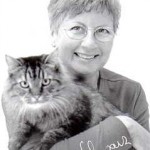 Information and photo taken from Tilleke’s website and book ‘Mark Making’.
Information and photo taken from Tilleke’s website and book ‘Mark Making’.
